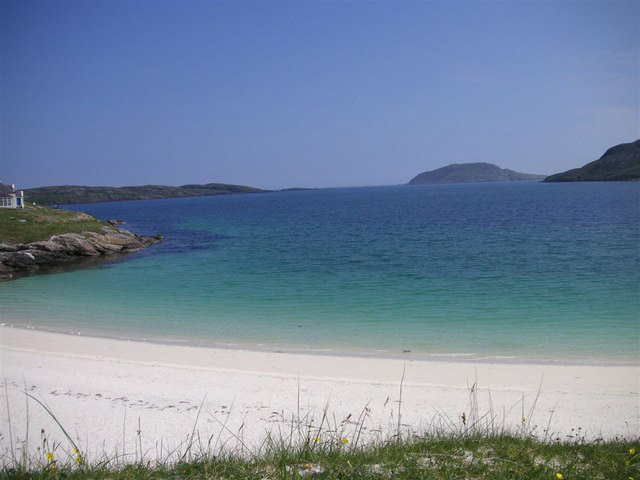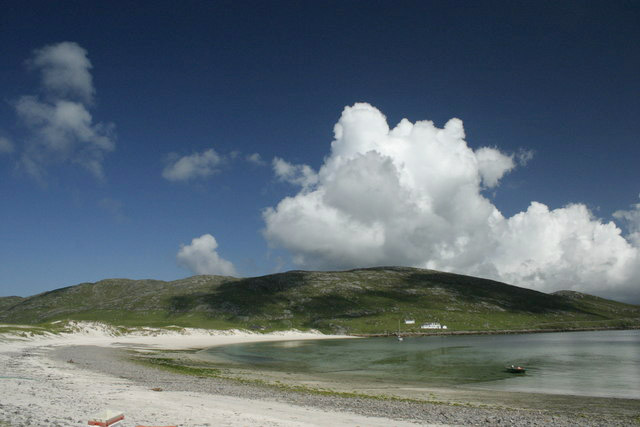![]()
![]()
Vatersay 1968.
VATERSAY EXPEDITION 1968
Leader: Philip Renold
Camp Administrator: Hugh Williams, Bill Abel, Pete Best, Fred Doyle, Olly Graham.
LEADER'S REPORT
|
It was all Bot's idea in the first place. At the Conference in January he got us all going with the crazy idea of organising our own expedition to Vatersay (none of us knew where it was). Things eventually started happening and after numbers had dropped from ten to five and then increased to six again we very nearly gave up. However, we persevered and eventually, at the end of August, found ourselves on one of the most beautiful Hebridean islands which I have ever seen. Vatersay is just south of Barra (the ferry from Castlebay takes about twenty minutes) and is the most southerly inhabited island (population: 80) in the Outer Hebrides as well as having the most westerly inhabited house (barring the army radar station on St. Kilda) in Great Britain (though not Northern Ireland). The island is formed of two rock outcrops running east to west with a "neck" of sand about five hundred yards wide and a mile long joining the two in the middle and on which we camped. Five beaches facing north, south, east, west, and north-west gave plenty of variety but all were deserted in strange contrast to those muddy stony ones in Italy where Fred had been a few weeks before and where every inch was covered in baking humanity! Come to the Riviera of the north for your holidays! I met Hugh at 6.30 on Monday, 19th August in Oban and after a rough crossing on the Claymore we arrived to find Castlebay windswept and wet. The weather prevented Hector MacLeod from running his regular ferry to Vatersay and so we had to spend the night camped in Castlebay. |

Vatersay Bay 11/06/2007 (Yes this is the Hebrides, not Bermuda! - Ed)
© Copyright Frances Watts |
|
The same bad weather which hindered us had also caused a disaster which affected us very closely. When visiting the island at Easter, Angus John MacNeil had acted as ferryman and had been very helpful. Alas, just before our arrival his boat, on a trip to Mallaig had been lost in a gale and all five crew on board, all from Vatersay, had lost their lives. This tragedy cast a shadow over the island but the islanders nevertheless made us very welcome in their midst. For the first three days the weather remained wet and windy and we were not helped by the absence of the marquee, stranded at Northbay Airport. After the other four had arrived on the Wednesday we decided to move our site to a more sheltered spot nearer the schoolhouse. Here we had a well drained site right beside the road which meant that there were no problems with stores and mail. |
|
However, the island having had very little rain for three months the streams soon ran dry when the weather improved. Consequently we had to get it from the schoolhouse, about two hundred yards away, in buckets. Alas, Mrs. Campbell's supply soon dried up so we were reduced to filling and getting Donald to deliver an old dustbin full of water from the village pump about a mile away. We soon learnt to leave this inside the marquee overnight after some inquisitive cattle had over turned the half-full dustbin and left us without water. The camp itself consisted of a 12 ft. by 12 ft. marquee, three sleeping tents, one food tent and one store tent as well as a "bog" tent. Other amenities were a gash pit (nicknamed "Janice") 8 ft. 2½ in. deep which we are claiming as an S.H.S. record. Some difficulty was experienced in collecting driftwood but the tables which we left there will remain for many a long year as a monument to our industry. Unfortunately we had to fill in the gash pit because it was a danger to passing cattle. Food was quite reasonable thanks to Hugh's efforts. Steak and kidney pudding tastes much better when cooked in an oven. Although I say it myself the bread (cooked up without a recipe) was quite edible, if a little "heavy". Having catered for eight and there only being six of us we certainly did not starve. Activities were not organised in any way, and some unused to this spent much time in sunbathing and playing football, perhaps regretting their lethargy later. Others "did" the island (2 miles north to south, each section 2½ miles and 3½ miles long east to west). All ports of the island, from Coalis to Earisdale were visited and photographed in the glorious weather which we had throughout our stay. Pete did ornithology and Olly attempted a geographical survey of the coastal features of Barra and Vatersay which was however hampered a little by a wayward member of the opposite sex. On Vatersay itself round houses and duns were examined and speculation was rife as to their origin. Very little of the early history of Vatersay is known because up until the turn of the century the island was owned by the Gordons and occupied by a tenant farmer. In 1907 (?) eleven men from Mingulay landed on Vatersay and refused to return to their island because they were too isolated and badly off there. Known as the "Vatersay Raiders" they demanded to be allowed to stay and occupy the island and eventually the Ministry of Agriculture stepped in and bought the island, and split it up into crofts. The following poem was written about them: |
 Theiseabhal Beag, viewed from the beach. 15/07/2007 © Copyright Stuart McMahon |
|
Presented to the Vatersay Raiders (in recognition of the valour) by the Lochs Land League. VATERSAY Giving to our country glory, Bright for a yet Shall be heard in song and story, Vatersay. For the dragon, Devastations Shows the ray, Charg'd with its annihilation, Vatersay. Here's a health to the eleven, In the fray. Whose devotion raised to heaven, Vatersay. May their children's children never Homage pay To the power from which they sever, Vatersay. As with life endowed, a thrilling Rock and clay With joy that now is filling Vatersay. All the Islands Hebridean, Soon may they Follow with the victor's pean— Vatersay
|
Vatersay was the first island to throw off the yoke of the tenant farmer whose house can still be seen, in ruins, above the village. Playing cards was our main evening activity. I never want to play Solo, Whist or Black Maria again. We arc claiming another S.H.S. record for playing Black Maria (we had another name for it) for twelve hours nonstop (10 p.m. to 10 a.m.). Playing cards was our main evening activity. I never want to play Solo, Whist or Black Maria again. We arc claiming another S.H.S. record for playing Black Maria (we had another name for it) for twelve hours nonstop (10 p.m. to 10 a.m.). |
|
© Copyright Hugh Venables |
By way of thanking the islanders we painted the inscription on a monument overlooking the west bay which reads:
Perhaps this small service will in part repay the islanders for all their help in time of another great tragedy, with the loss of the "Marie Dhonne" in the Minch.
|
In particular our thanks must go to Mrs. Campbell, the schoolmistress who lent us everything from a dustbin to methylated spirits and in whose house we had many a cup of tea. I would also like to thank Mr. MacQueen at Oban High School, McCulloch's in Oban, the S.C.W.S. Castlebay, Hector MacLeod the ferryman and Donald Campbell the postman as well as Mr. S. L. Hamilton of the Ministry of Agriculture, Fisheries and Food for Scotland who gave us permission to use the island. The expedition suffered from being too small in numbers but apart from this it was successful and I enjoyed myself and intend to return to Vatersay someday soon.
Philip Renold
THE CAMP After a few days on Vatersay we managed to find a camp site which was ideal in most respects. The soil was sand, the surrounding dunes sheltered us and, when it rained, the hills provided water. We were very close to the sea, there being two magnificent shell-sand beaches on either side of our site. Apart from our lack of numbers (only six) and the fact that two people had to leave early, our greatest disadvantage was our closeness to civilisation. Our glorious leader (quickly renamed John B. Dob Mk. II) was frequently to be found in local houses, sitting down under the excuse of sociology, drinking tea or anything stronger that was offered (just jealous, that's all—P.N.R.). The camp set-up was good. The marquee was divided into two parts, one for preparing food and the other for playing cards in the evenings, drinking coffee and eating (in that order!). Use of gadgets (self-emptying ash-trays, mug racks etc.) made camp life much easier. When all is taken into account the expedition may have left something to be desired but it was certainly an experience, and a most enjoyable one at that!
Hugh Williams